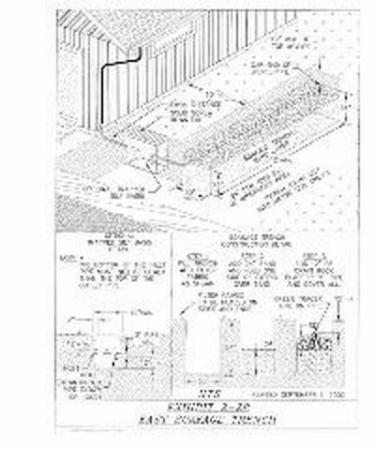Soakage Trenches
A soakage trench is a shallow trench in permeable soil that is backfilled with sand and coarse stone, and lined with filter fabric. Water from rooftops is diverted into the trench, where pollutants are filtered from the water and groundwater is recharged through infiltration. The trench surface may be covered with grating, stone, sand, grass, or plantings.
Note: ALL soakage trenches that receive stormwater from any source MUST be registered with the Oregon Department of Environmental Quality (DEQ). Trenches that only receive roof runoff are considered “Rule Authorized”, but must still be registered with the state. If a soakage trench will receive runoff OTHER than rooftop runoff, pollution reduction (settling pond, filtering, etc.) is required prior to disposal, and must be authorized by DEQ. For more information and registration forms, please go to the DEQ website
The City can provide assistance filling out the residential permit form.
Specifications
Appropriate soil conditions are extremely important for proper functioning of soakage trenches. Soils must have a tested infiltration rate of greater than 2 inches per hour, and must have full drawdown time less than 10 hours. The trench must infiltration the entire design storm without overflow. Soakage trenches must be clearly marked before construction to prevent any vehicular traffic, with the exception of equipment used specifically to construct the facility, within 10 feet of the area. There must be a minimum of 4 feet of undisturbed soil between the bottom of the facility and any impervious layer or seasonal high water table.
Minimum sizing for a private soakage trench is 30” wide and a minimum of 12 feet long, and is suitable to treat 500 square feet of roof surface. The trench shall be filled with a minimum of 24 inches of medium sand, overlaid by filter fabric, and covered with a minimum of 12” of ¾” to 2 ½” round or crushed rock. The perforated pipe carrying the runoff is then laid on top of the gravel and covered with filter fabric. A minimum cover of 12” of backfill is required over the pipe. The bottom of the facility must be flat, or have clay check-dams to prevent water from ponding at the downstream end of the facility.
Minimum required setbacks are 10 feet from any building structures, 5 feet from property lines, and 5 feet from public utilities. The soakage trench should be located downslope of any buildings.
Maintenance Requirements
- Identify and repair any clogging that may prevent water from infiltrating after a storm event, including, but not limited to:
- debris/sediment accumulation on the surface;
- sediment accumulation in the gravel layer
- sediment accumulation in the perforated pipe
- Prevent the disposal of hazardous or toxic materials in or near the soakage trench
Resources Used
- City of Gresham Department of Environmental Services Stormwater Division. Water Quality Manual. Summer 2003.
- City of Oregon City. City of Oregon City Stormwater and Grading Design Standard; Chapter 5 of City Code.
- City of Portland Bureau of Environmental Services. Stormwater Management Manual. July 1, 1999; Revised 2004
- Clean Water Services. Design and Construction Standards for Sanitary Sewer and Surface Water Management. March 2004.
- Additional information and resources are available on the City of Portland Bureau of Environmental Services web p Soakage Trenches

